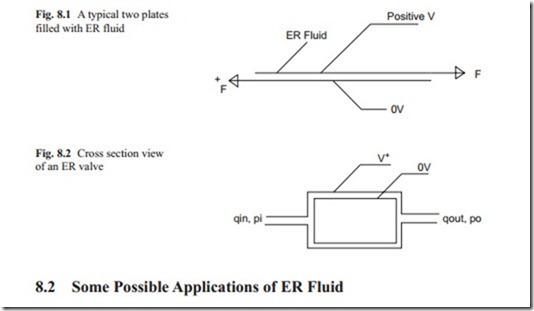Introduction
Electro-Rheological (ER) fluids are special fluids made of base hydraulic fluids with chargeable particles suspended in the fluids. The important properties of ER fluid is that when it is put between two plates with gap h (typical of less than 1 mm) and a voltage is applied on the two plates, the fluid becomes stiffer with shear stress of typical 2 kN/m2 has been reported. This is shown in Fig. 8.1. The range of the applied voltage is 4 kV/mm. The current drawn is very small and it is the range of a few milliamps.
When the gap is filled with ER fluid, and the voltage is applied on the plates, the fluid becomes stiff and the plate subjected to force F, a resistance is observed. The amount of resistance is the function of gap sizes and the applied voltage and the type of ER fluid is used. There are several types of ER fluid available in the market with different values of maximum shear stress for a given gap and applied voltage. The voltage cannot be increased very large because there may be spark flashing through the gap. The maximum force applied to the plates depends on the gap size and the fluid. It has been shown that the voltage does not change the fluid viscosity but the particles suspended in the fluid forms a chain that prevents the fluid from flowing. In this form, ER fluid has many potential applications such as valves, clutches, and variable dampers. At present because of sensitivity to temperature and low overall yield stress have limited its application to only laboratory test equipments. Some practical applications may emerge in the near future. This chapter provides up to date information about the characteristic behavior of ER fluid in shear and valve modes. The author has been involved in both processing the data from flow and shear modes of experimentation. The information provided in this chapter is the result of identification technique and data processing technique. The technique used will be described briefly but only the results are presented in this chapter.
